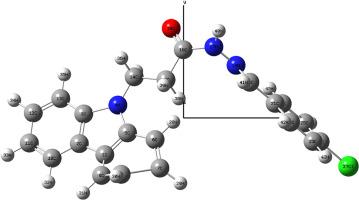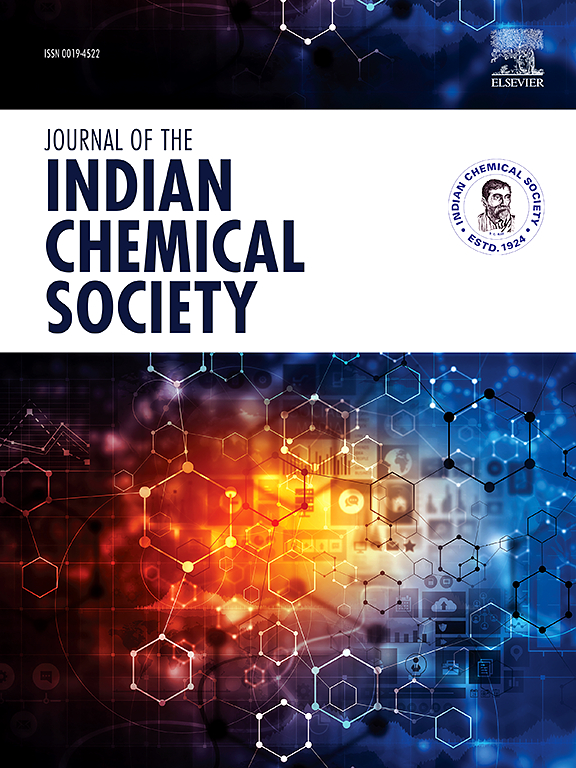利用 DFT 计算抗癌剂 9H-咔唑连接 4-氯苯甲醛的合成、结构机理、RDG、生物学和药学意义
IF 3.2
4区 化学
Q2 CHEMISTRY, MULTIDISCIPLINARY
引用次数: 0
摘要
在本研究中,我们对 9H-咔唑连接的 4-氯苯甲醛(9HCNPH)的光谱特征和生物特性进行了实验和理论相结合的研究。本研究利用傅立叶变换红外光谱/拉曼光谱、核磁共振化学位移(13C 和 1H)和紫外可见光技术对 9HCNPH 化合物进行了实验和理论分析。实验记录的 X 射线晶体学数据、振动赋值、电子跃迁和核磁共振化学信号与采用高斯 09W 程序的 B3LYP/6-311++G(d,p) 模型十分吻合。分子轨道理论(MO)用于确定 9HCNPH 分子内的 HOMO-LUMO 能隙和电荷转移相互作用或电子传输过程,以及计算量子化学描述符全局硬度、软度、电负性、化学势和电负性。此外,还报告和讨论了分子的进一步特性,如等表面密度、NLO、自然和原子群分析。此外,还预测了五项规则和生物活性,从而使我们认识到标题分子可能是一种抗癌剂。分子对接研究讨论了活性最高的化合物 9HCNPH 与 4LPB 和 1T8L 靶蛋白活性位点之间的潜在相互作用。细胞毒性测试结果表明,该药物的 IC50 值为 20.9 μM,具有良好的抗癌活性。本文章由计算机程序翻译,如有差异,请以英文原文为准。

Synthesis, structural mechanisms, RDG, biological and pharmaceutical significance of anticancer agent 9H-carbazole attached 4-chlorobenzaldehyde using DFT reckonings
In this study, we report a combined experimental and theoretical study on spectroscopic profiles and biological characteristics of 9H-carbazole attached 4-chlorobenzaldehyde (9HCNPH). The 9HCNPH compound was experimentally and theoretically analyzed by using FT-IR/Raman, NMR chemical shifts (13C and 1H) and UV–Vis techniques. The experimental X-ray crystallographic data, vibrational assignment, electronic transitions and NMR chemical signals were recorded and are in good harmony with the B3LYP/6–311++G(d,p) model employing the Gaussian 09W program. The molecular orbital theory (MO) is used to determine the HOMO-LUMO energy gap and charge transfer interactions or electron transport processes taking place within the 9HCNPH molecule, as well as to calculate the quantum chemical descriptors global hardness, softness, electronegativity, chemical potential and electronegativity. The molecular further properties such as isosurface density, NLO, natural and atomic population analysis were also reported and discussed. Moreover, the Rule of five and biological activities were also predicated, thus allowing us to recognize the title molecule as a probable anticancer agent. The molecular docking studies were conducted to discuss potential interactions between the most active compound 9HCNPH and active sites of 4LPB and 1T8L target proteins. According to the findings of cytotoxicity tests, the promising anticancer activity of the drug agent was measured at an IC50 value of 20.9 μM.
求助全文
通过发布文献求助,成功后即可免费获取论文全文。
去求助
来源期刊
CiteScore
3.50
自引率
7.70%
发文量
492
审稿时长
3-8 weeks
期刊介绍:
The Journal of the Indian Chemical Society publishes original, fundamental, theorical, experimental research work of highest quality in all areas of chemistry, biochemistry, medicinal chemistry, electrochemistry, agrochemistry, chemical engineering and technology, food chemistry, environmental chemistry, etc.

 求助内容:
求助内容: 应助结果提醒方式:
应助结果提醒方式:


